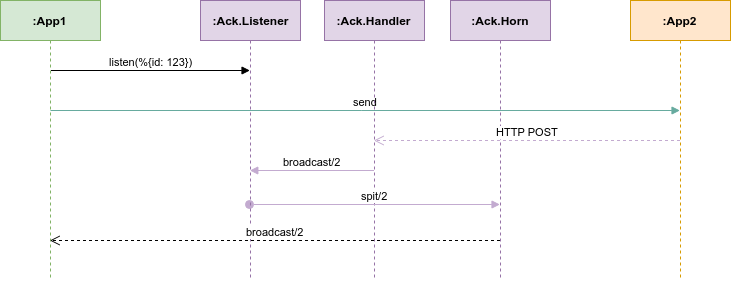View Source
 Ack With Ease
Ack With Ease
What?
Ack is designed to be a lightweight easy-to-use implementation of interprocess acknowledgement, whatever it means. According to Wikipedia:
In data networking, telecommunications, and computer buses, an acknowledgement (ACK) is a signal passed between communicating processes, computers, or devices to signify acknowledgement, or receipt of message, as part of a communications protocol. The negative-acknowledgement (NAK or NACK) signal is sent to reject a previously received message, or to indicate some kind of error. Acknowledgements and negative acknowledgements inform a sender of the receiver's state so that it can adjust its own state accordingly.
That said, when the independently running process is to pass a message around to another process—via some complicated pipe—that makes it hard to ensure that all parts of this pipe delivered the message successfully and/or instead of propagating the success/failure back through each link in this chain, the sender might simply require ACK back when the message was successfully delivered to the recipient.
This could involve the additional level of complexity when we are talking about tiny microservices. Not each and every microservice are to have a bucket of intercommunication clients included. Lightweight ones might have none in fact. This package is a drop-in solution for such cases.
It probably does not apply when all involved processes come with messaging queue and fully-functional web server on board.
Why?
This package comes with all the boilerplate included, including lightweight web-server based on Camarero and process message broadcasting with Envío. It drastically simplifies adding ACK support to lightweight microservices. Indeed, all one needs would be to:
- add
Ackto the list of applications started withApp1 - implement
Envio.SubscriberinApp1, listening to any of three following channels:{Ack.Horn, :ack}{Ack.Horn, :nack}{Ack.Horn, :error}
- implement
App2toHTTP POSTtoApp1.domain:30009one of two requests (assumingkeyis somewhat negotiated upgront and known toApp1):%{"key" => key, "value" => "ack"}toack, or%{"key" => key, "value" => "nack"}tonack
The control flow of each ACK would be as shown below.

The whole implementation required from App1 to start supporting ACKs would look like (besides the business logic handling ACKs and NACKs):
defmodule MyApp.AckHandler do
use Envio.Subscriber,
channels: [{Ack.Horn, :ack}, {Ack.Horn, :nack}, {Ack.Horn, :error}]
def handle_envio(%{key: key, status: status} = message, state) do
state = BusinessLogic.on_response(status, for: key)
{:noreply, state}
end
endTo start expecting for the ACK, one simple calls Ack.listen/1 passing the following map as a parameter of a type Ack.t:
Ack.listen(%{key: "user_123", timeout: 5_000})When the callback with a payload having %{} will be received, the message will be broadcasted to all the pub-sub listeners of one of aforementioned Ack.Horn channels, depending on the state.
The whole implementation required from App2 to start supporting ACKs would be to HTTP POST to the predefined endpoint the message of a shape %{key: entity_id, value: :ack or :nack}.
That’s it.
Why not?
In many [over]complicated systems there are already robust queue-based ack-back pipelines presented. If the whole system already has the intercommunication pipeline, providing back-and-forth validation and monitoring of everything, Ack would most likely not suit. Still, it’s robust and comprehensive.
Is it of any good?
Sure, it is.